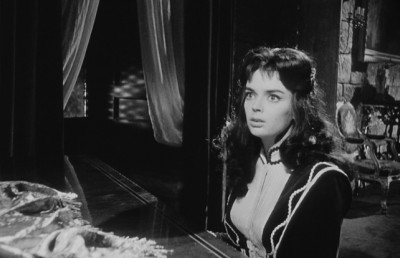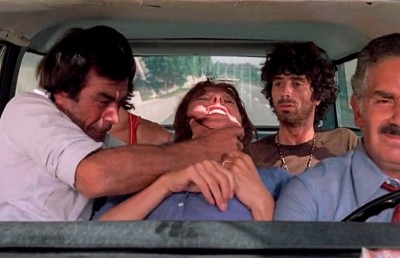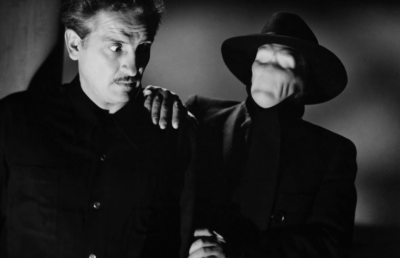“La donna è mobile…” Mario Bava and the Eternal Feminine
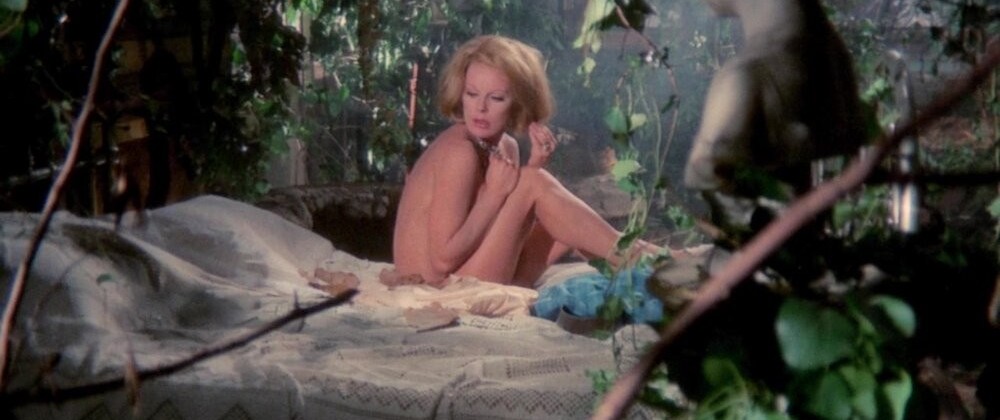
[Warning: this essay contains spoilers]
In October 2019, during an extensive retrospective on Italian gialli at Vienna’s Film Museum, a female member of the audience complained that there should have been a warning about the films’ controversial content and claimed she felt offended by it. Had Dario Argento been attending, he might have felt a déjà-vu. In 1972, after a screening at Bologna’s film school DAMS, the director was verbally attacked by an audience of students who called him a fascist, asked him why he always killed women in his films and told him that the violence in his films was criminal offence. One feminist student said that he ought to be ashamed of himself and, had she met him in the street, she would have slapped him in the face.
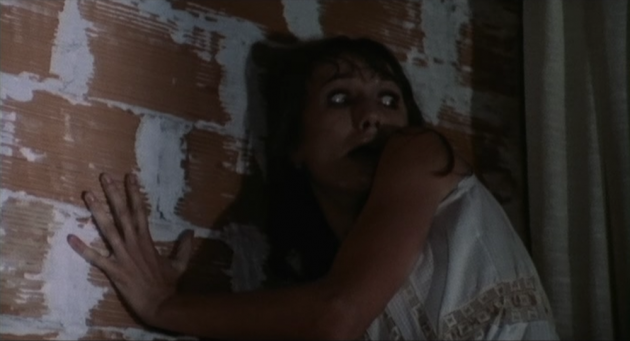
Daria Nicolodi (R.I.P.) in Shock
Argento’s good faith was undisputable. “In my films I kill more women because I love them more,” 1 he confessed in his memoir. But the same could not be said about some of the epigones. Caught between the post-1968 libertarian temptations and the burden of Catholic heritage, the giallo attempted to balance such conflicting issues in an uneasy commercial compromise. This spectacularly controversial procedure was taken to its extremes in such films as Roberto Montero’s Rivelazioni di un maniaco sessuale al capo della squadra mobile (aka So Sweet, So Dead) where a maniac dispatches unfaithful wives in a small Sicilian town, and Renato Polselli’s Delirio Caldo (aka Delirium), both released in 1972.
It is true, indeed, that 6 donne per l’assassino (aka Blood and Black Lace, 1964) turned the act of killing women into the giallo’s main attraction, and that the Argento-esque thrillers made after L’uccello dalle piume di cristallo (aka Bird with the Crystal Plumage, 1970) often revolved around black-gloved killers stalking and offing in sadistic ways an array of unfortunate victims. But not all gialli are about killing beautiful and scantily dressed women. In Il gatto dagli occhi di giada (aka Watch Me When I Kill, 1977, Antonio Bido) the victims are all middle-aged types with a despicable past, and the murder of Fernando Cerulli’s character—ugly, skinny, pale-looking—strangled in the tub while taking a bath, is a grotesque reversal of the giallo’s trademark exploitative blend of sex and violence. And, it should be added, not all female characters adhere to the trite and admittedly sometimes downright offensive stereotypes offered by some of these films.
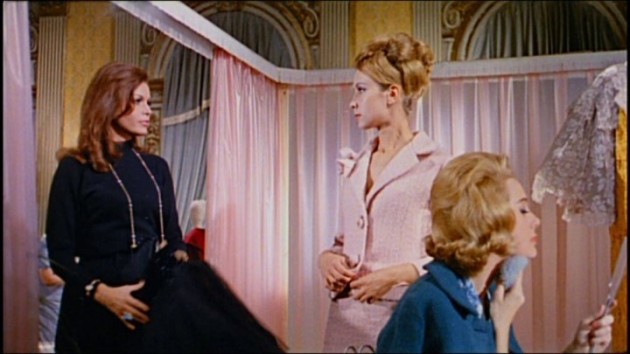
6 donne per l’assassino
Let’s take the undisputed predecessor, 6 donne per l’assassino . Of the titular “six women for the murderer” in Bava’s film, five—the models of the fashion house run by Countess Cristiana (Eva Bartok) and her partner Massimo (Cameron Mitchell)—are nondescript, barely distinguishable one from another, selfish, gossipy, vain and ultimately forgettable cyphers. These “poor ragazze who don’t know too much,” as the Cahiers du Cinéma labelled them jeeringly, are “stereotyped silhouettes, disturbing photonovel figures […] like the wheels of a machine that sends them, one by one, to nothingness.” 2 Their names, faces, words, feelings, actions, are instantly forgettable. Their very existence is merely functional to their demise: like mannequins come to life for the time it takes to be killed and therefore turn back to inanimate state. But what about the sixth? Cristiana comes off as the only character in the film worth a minimum of affection. She is a murderer, for sure, but she is also a victim.
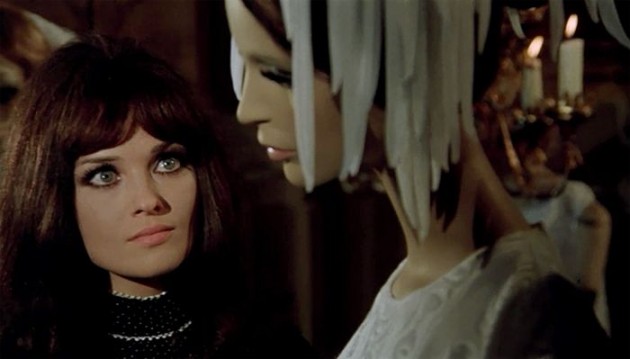
Hatchet for the Honeymoon
In a way Cristiana is akin to Nevenka (Daliah Lavi) in La frusta e il corpo (aka The Whip and the Body, 1963). Both women are tied to their lovers by a secret and perverted relationship which ends tragically. But the fatalistic romanticism and the amour fou of La frusta e il corpo here leaves room for a more squalid context, and the last part of 6 donne per l’assassino recalls certain middle-class melodramas of the previous decade, in which the heroine is subjugated by her mean-spirited lover and pushed to humiliating acts. Take the scene where Cristiana and Massimo are in bed, planning their next move, the man wearing a foulard around the neck and a half-open dressing gown, and looking more like a cut-rate gigolo than the distinguished gentleman he aims to be. As he persuades his half-drunk, submissive partner in crime to commit one last killing, the squalor of a mismatched clandestine couple emerges fully. In the end Cristiana becomes a pathetic, rather than tragic, figure: a woman betrayed, exploited and even sacrificed by the man she desperately loves.
Even though it relies on genre stereotypes, Bava’s cinema is full of unusual, complex female characters, whether they be female vampires, ghosts, witches, reincarnations, or just plain middle-class housewives, leading to interesting variations on the clichéd representation of gender. 6 donne per l’assassino overturns the power dynamics at the core of Bava’s debut La Maschera del demonio (aka Black Sunday, 1960), in which Asa the vampire witch (Barbara Steele) is an avenging seductress who has all men at her feet: she vampirizes Kruvajan (Andrea Checchi), treats her undead paramour Javutic (Arturo Dominici) as her manservant, and almost succeeds in putting the weak hero (John Richardson) under her spell. Bava’s debut explored the duality at the core of the Italian Gothic thread and set out a pattern frequently emulated by others, with Steele playing both the evil Asa and the virginal heroine, Katja; and yet, many of his subsequent works got rid of such a dichotomy or shuffled the cards. Nevenka and Cristiana, in fact, are two-sided characters who, like a Janus’ head, can be victims or villains depending on the perspective from which one looks at them.
Even though it admittedly features a weakly-scripted heroine (Erika Blanc’s Monica), Operazione paura (aka Kill, Baby… Kill!, 1966) depicts a far more interesting female character, the raven-haired local “witch” Ruth (Fabienne Dali). Feared and marginalized by the villagers who nonetheless seek her help to defeat the curse that haunts the village, Ruth is the red thread that ties the alleged Northern-European Gothic microcosm of Operazione paura to the Italian folklore and tradition. In a scene she performs a magic ritual on a teenage girl (Micaela Esdra), forcing her to use a thorny cilice as an instrument of forced contrition to drive evil away. The sequence evokes the mixture of religion, superstition, and sexual repression typical of the backward Southern regions, in a way akin to Brunello Rondi’s extraordinary Il demonio (1963, starring Daliah Lavi) as well as Fulci’s Non si sevizia un paperino (which featured a similar character, the “maciara,” played by Florinda Bolkan) and partly to Giulio Questi’s underrated Arcana (1972, starring Lucia Bosé).
Ruth’s opponent, the elderly Baroness Graps (Giovanna Galletti) is a long way from Italian Gothic’s ageless seducers as seen in Riccardo Freda and Bava’s I vampiri (aka The Devil’s Commandment, 1957) and La Maschera del demonio, who eventually revealed their physical rot and decaying flesh, much to the viewer’s horror. Graps is a disheveled old woman whose hair resembles the cobwebs that dot her abode and which often act as a veil between the camera and the characters, thus detaching things and persons from our sight, as if they were imprisoned in a painting – just like the one portraying Villa Graps in the film’s most celebrated scene.

Laura Betti as the ‘haunting’ bride in Hatchet for the Honeymoon
Bava’s disdain for stereotypes is perhaps best summarized by Il rosso segno della follia (aka Hatchet for the Honeymoon, 1970). Here, fashion house owner John Harrington (Stephen Forsyth), haunted by the memory of his mother’s death which he witnessed as a child, kills women who are about to get married while wearing a bridal veil himself. The infantile and impotent Harrington is in turn unhappily married to Mildred, who does not want to divorce and returns to torment him as a ghost after he has killed her in a fit of madness. Santiago Moncada’s script depicted the bitchy Mildred as a very beautiful woman, thus evoking a rather banal femme fatale stereotype. In an off-putting casting choice, Bava gave the role to Laura Betti, whose plump features, pout and unpleasant laughter are poles apart from Barbara Steele’s seductive grace, and highlight Bava’s bizarre sense of humor. The director and Betti teamed up again (with the actress playing a nosy tarot reader who meets a nasty end) in Reazione a catena (aka Bay of Blood, 1971), which in turn features another sardonic variation on the theme of the diabolical couple, with a strong-willed wife, Renata (Claudine Auger) pushing her weak and remissive husband Alberto (Luigi Pistilli) to dispatch innocents and get hold of an inheritance… with unexpected results.
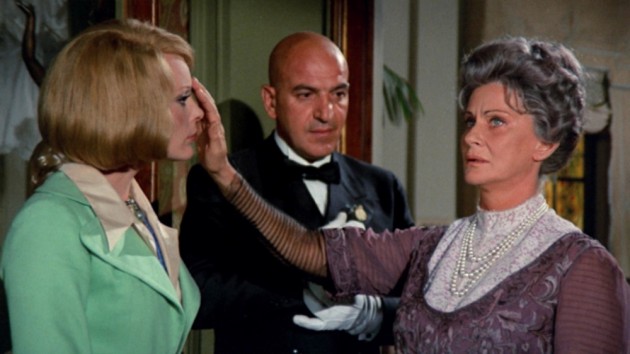
Lisa and the Devil
Lisa (Elke Sommer), the titular heroine of Lisa e il diavolo (aka Lisa and The Devil, 1973) is perhaps the director’s most enigmatic incarnation of the eternal feminine. She is introduced as a modern-day, independent, single woman on a trip to Toledo, but once she loses herself in the maze-like alleys of the Spanish town, appearances are destined to fall and Lisa’s very essence changes like a chameleon’s skin. Over the course of the story, she gradually realizes she is not who she thought she was. Once again in Bava’s cinema the theme of the double is the key to enter the story: Lisa is the doppelgänger (or the reincarnation?) of Elena, the woman loved by Massimiliano (Alessio Orano), who had killed her after discovering her affair with his stepfather Carlos (Espartaco Santoni) and preserved her dead body on the nuptial bed. Far from being a new incarnation of the classic maneater type in the vein of Helen of Troy and Cleopatra—to whom the devilish butler Leandro (Telly Savalas) compares her—, though, Lisa is a detached, passive, enigmatic character, and ultimately is revealed to be a puppet-like figure, an empty simulacrum maneuvered like all the other characters by a mocking devil. Bava’s metaphysical meditation on the volatility of existence and human passions leads to a bitterly paradoxical ending.
According to Lamberto Bava, his father was very puritanical and uncomfortable with filming sex scenes (so much so that it was Lamberto who shot the one between Sylva Koscina and Gabriele Tinti in Lisa e il diavolo) 3 , but his view on sexuality and morality has surprising nuances. In _Il telefono (from I tre volti della paura, 1963, aka Black Sabbath), the prostitute played by Michèle Mercier survives, unlike her repressed lesbian roommate (Lydia Alfonsi); the debauched characters of 5 bambole per la luna d’agosto (aka Five Dolls for an August Moon, 1970) are systematically offed, and so are the empty-headed bimbos of Reazione a catena; but Diabolik (aka Danger: Diabolik, 1968) is much more erotic than the comic book upon which it was based, and sports a joyful amorality, as when Diabolik (John Phillip Law) covers the body of his lover Eva Kant (Marisa Mell), lying naked on the bed, with banknotes, or when he places stolen emeralds directly over her naked flesh. Finally, the unproduced Pornogiove, albeit likely prompted by commercial motives, conveyed an idiosyncratic, thought-provoking look on a pre-Christian era characterized by sexual freedom and devoid of the Catholic sense of sin.
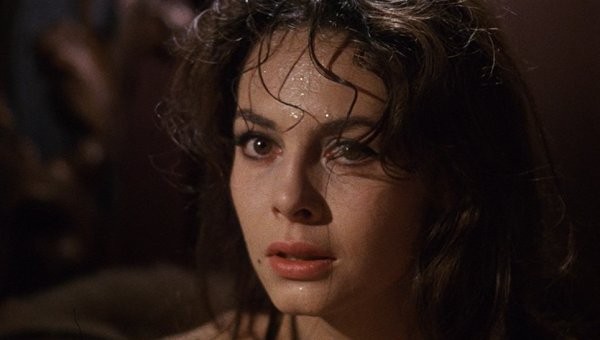
Black Sabbath, The Telephone episode, featuring lesbian characters that were censored in the US release
The director’s last theatrical feature film, Shock (aka Beyond the Door II, 1977) reprises the duality at the core of La frusta e il corpo, with a heroine who is both a caring mother and a crazed axe murderer; but it reinvents the earlier film’s feverishly romantic halo into an ordinary middle-class contemporary context. It is a ghost story devoid of the Gothic pulp, and in which characters and places are covered with a veil of everyday mediocrity. Compared with Bava’s previous horror movies, it is unusually inconspicuous, and overall it conveys a sense of emptiness comparable to the one that assaults the eponymous heroine at the end of Lisa e il diavolo. It is a sign of the times. Dora Baldini (Daria Nicolodi) is not a triumphant princess of evil who lives in a haunted castle, but a quiet middle-class housewife who fixes sandwiches in the kitchen for her friends in her nondescript suburban home, waiting for her husband (John Steiner) to return from his business trips; and the past that returns to torment her is not a centuries-old curse, but a squalid drug addiction. Even the theme of sexual dissatisfaction takes new and surprising forms. In Danza macabra (aka Castle of Blood, 1964), the undead Elisabeth Blackwood (Barbara Steele) claimed, “I live only when I love!” Dora, whose sexuality has been suppressed by motherhood, lives (and loves) only when she dreams: the amazing sequence of her erotic dream—in which Nicolodi’s hair moves around as if caressed by an invisible hand, courtesy of Bava’s umpteenth wizardry—marks the nocturnal metamorphosis of a woman who found refuge from madness in the mediocrity of the family routine.
Bava’s final work, the made-for-tv La Venere d’Ille (made in 1978 and co-directed with his son Lamberto, but aired only in 1981, a year after his death) touches not only themes that were typical of the Gothic and of his own cinema, such as the doppelgänger and the perturbing confusion between the animate and inanimate, but also contemporary issues. In part this is due to the contribution as co-scriptwriter by Cesare Garboli, a distinguished literary critic and a scholar of the works of such important and groundbreaking female writers as Elsa Morante and Natalia Ginzburg. Therefore, Prosper Mérimée’s short story about a bronze statue which comes to life to reclaim her spouse on his wedding night, a misogynist fantasy centered on the umpteenth incarnation of the vagina dentata myth, becomes a tale of retaliation in a period characterized by feminist struggles, and the bronze Venus (which, once extracted from the ground, marks the downfall of the wealthy Peyrehohade family) is an alien presence that puts in check the gears of patriarchy, as well as its continuous abuse of the female condition.
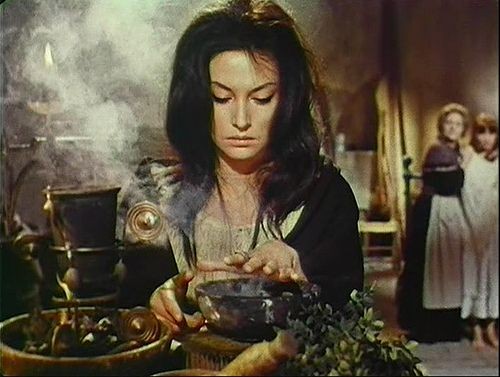
Fabienne Dali, as the progressively depicted witch in Kill, Baby Kill
It is a scenario Bava had marginally explored in I Wurdalak, the central episode of I tre volti della paura (aka Black Sabbath, 1963), which depicts a barbaric world based on oppressive hierarchical rules: family life revolves around the elderly patriarch, who is served and revered as a king; his male progeny follows his every word, no matter how unreasonable, without batting an eyelid; women are passive and obedient. It was a scenario close to Italy’s rural culture, which was gradually disappearing after the war, following mass emigration to the big cities and the development of industries. The character of Vladimir, a traveler from the city, became a spectator of this backward social system (an element emphasized in Giorgio Ferroni’s 1972 modern-day remake, La notte dei diavoli) who is eventually coopted into it. The vampire contagion spawned by old Gorka sets in motion a process of rebellion and (apparent) emancipation which apparently destroys the whole family, only to prepare for its reconstruction and strengthening. Maria (Rica Dialina) kills her husband Giorgio (Glauco Onorato) who was preventing her from opening the door to their little vampire son, while the submissive Sdenka (Maria Antonietta Goldi aka “Susy Andersen”) becomes a seductress after turning into a vampire and bites Vladimir before the eager eyes of the patriarch Gorka (Boris Karloff) and the other vampires. The scene works as an implicit paraphrase (yet in reverse) of the ritual wedding defloration. An entire family welcomes and covets a new member.
Likewise, in La Venere d’Ille we witness through the eyes of a foreign observer—the artist Mathieu (Marc Porel)—the female role in a pleasure-loving and vulgar patriarchal society, which treats woman as something to take and consume before moving on to something else. Bava emphasizes the humiliating circumstances of Clara’s (Daria Nicolodi) marriage to Alfonso (Fausto Di Bella): a young, beautiful and cultivated woman from a wealthy family, she gets marries not out of love but because of commercial convenience to a man who just wants her family fortune. And yet, Clara is not merely a passive character as it would seem upon first glance: there is a noticeable pleasure in her voice, when she reveals to Mathieu her physical attraction to her future husband, and there is an impatient anticipation in the sequence where she prepares for the wedding night, taking a bath and surrounded by maids, and in the thrill with which she welcomes what she believes to be her husband in the nuptial bedroom. Like the heroine of André Pieyre de Mandiargues’ short story Le Sang d’agneu (in the anthology Le Musée noir), in the moment she chooses to give herself to the man, sacrificing herself to love, Clara brings him to ruin, which here takes the form of the Venus’ deadly embrace.
The ending of La Venere d’Ille, with the burning of the statue that is cast in order to be transformed into a bell, recalls the opening of La Maschera del demonio and chisels the director’s filmography in a mirror-like way. But the expression we glimpse on the statue’s face among the flames is a mocking, cruel smile; put to the stake, dissolved in its identity, and submitted to a cruel retaliation that turns it from Pagan symbol to a sacred object, the Venus nevertheless remains unattainable. And triumphant.
Notes
- Dario Argento, Fear. The Autobiography, Godalming, Sorrey: Fab Press, 2019, p. 109. ↩
- “Six femmes pour l’assassin,” Cahiers du Cinéma #163, 1965, February 1965. ↩
- Lamberto Bava, quoted in Manlio Gomarasca and Davide Pulici, “Il talento di Mr. Bava,” in Genealogia del delitto. Il cinema di Mario e Lamberto Bava. Nocturno Dossier #24, July 2004, p. 15. ↩



